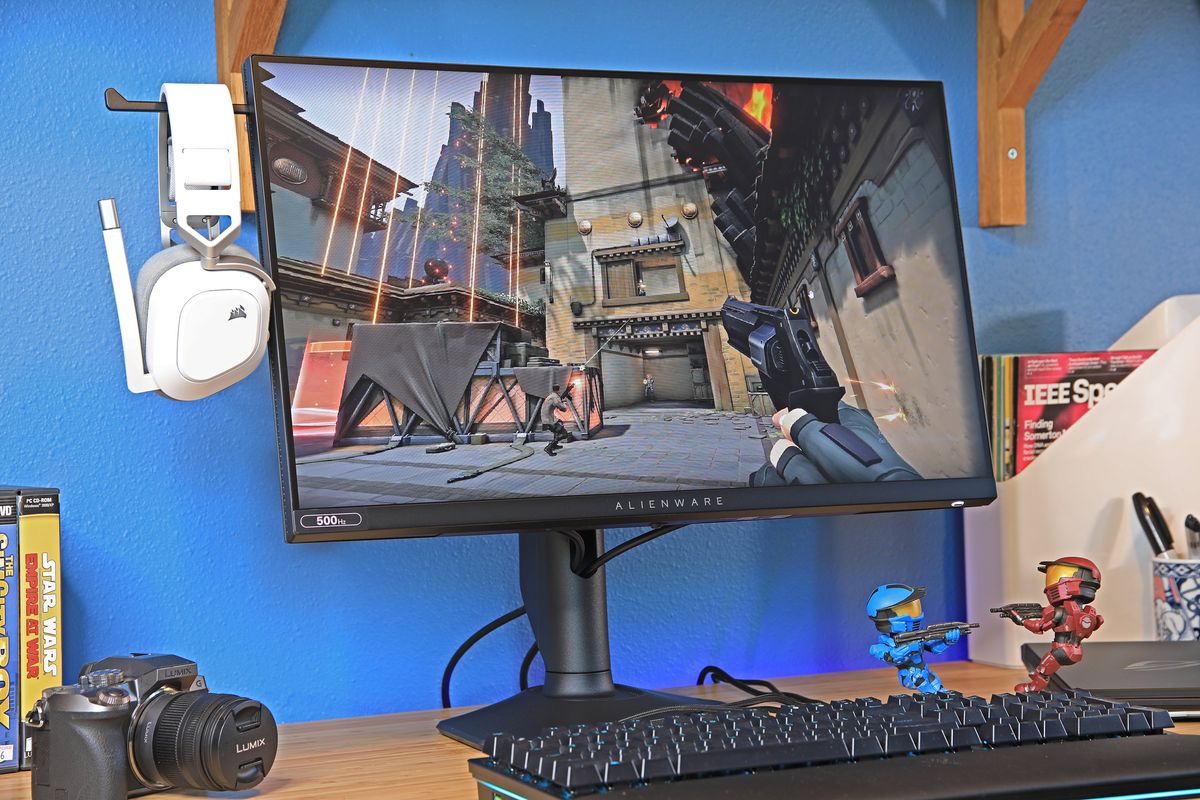Computer monitors have improved tremendously since the first mainstream color LCDs edged out CRT displays two decades ago. But odds are high the motion performance of the monitor you’re using right now is far from perfect.
This is the reality of modern displays with a 60-hertz refresh rate, which refresh their image 60 times each second. However, not all displays share this limitation. Apple delivers a 120-Hz refresh rate in the iPhone Pro and MacBook Pro. Sharp’s cutting-edge Aquos R8 smartphone provides a refresh rate up to 240 Hz. And displays built for competitive e-sports, like the Alienware AW2524H, push refresh rates up to 500 Hz.
“If the ideal means the fastest and smoothest graphics, then 500-Hz refresh is the most ideal at the moment,” says Yoon Lee, vice president of displays at Dell Technologies.
As refresh rates run higher, challenges remain
Modern displays, including LCD and OLED displays, use a technique called “sample-and-hold.” Frames are displayed and held for a period determined by the refresh rate (a 60-Hz display holds a frame for 16.667 milliseconds).
But there’s a problem. A 60-Hz sample-and-hold displays a new image only once every 16.667 milliseconds, so the moving object “jumps” from frame to frame. The human eye perceives this as motion blur.
The 2005 paper “LCD Motion Blur Modeling and Analysis” found that “under current LCD technology with 16 ms response time, about 70 percent motion blur is caused by hold-type, and 30 percent motion blur is caused by slow response.” Blur Busters, a website dedicated to eliminating blur in modern displays, has an interactive demo that illustrates the point.
“To achieve an infinite refresh rate, the display charging time would need to be instantaneous, which isn’t physically possible.”
—Yoon Lee, VP displays, Dell
There’s one solution: a higher refresh rate. A 500-Hz display, like Alienware’s AW2524H computer monitor, displays each frame for a mere 2 milliseconds. But achieving a high refresh rate is no simple matter.
“To obtain high refresh rates, the panel needs to charge and discharge quickly. We call this the display charging time, and it’s determined by the thin film transistor (TFT) backplane technology,” says Yoon. “With today’s panel technology, 500 Hz, or slightly higher with overclock, is the maximum refresh rate the panel can reach.” Alienware’s display is one of a kind, although Asus says it will release a similar display by the end of 2023.
The ideal sample-and-hold display would offer a nearly infinite refresh rate: Imagine thousands or tens of thousands of frames per second. Unfortunately, the laws of physics intervene. “To achieve an infinite refresh rate, the display charging time would need to be instantaneous, which isn’t physically possible,” says Yoon.
From e-sports to iPhone
Nevertheless, more modest improvements are still useful. I personally tested Alienware’s 500-Hz monitor and witnessed huge gains in motion clarity. Objects that would normally smudge into a blurry, ill-defined mess appear crisp and clear, making it possible to identify small details. That’s a key improvement for Alienware’s core audience: professional and amateur competitive gamers.
“At the moment, the use case of monitors with such high refresh rates is predominantly gaming,” says Yoon. “We see demand for such high refresh rates going beyond professional e-sports players […] as graphics cards become more powerful and cheaper over generations.”

But, in some situations, the improvements extend beyond gaming. Scrolling through text in a Word document or PDF usually makes the contents unreadable—indeed, this is so common that most people wouldn’t think to expect anything different. Try it on a 500-Hz display, however, and the document appears shockingly clear. Even small fonts are detailed and easy to read. Similar benefits are noticeable when opening apps and moving or resizing windows.
High refresh rates also reduce input latency, as each new frame appears more quickly. This again provides different benefits for different users. E-sports players believe it’s a competitive advantage, as they’ll see in-game action a few milliseconds before their foes. On smartphones, and other touchscreen devices, a high refresh rate reduces the delay between tapping the touchscreen and seeing a response. Apple advertises the feature as “ProMotion,” and it’s one of several differences between the entry-level iPhone and iPhone Pro.
Beyond 500 Hz
High-refresh-rate displays are rippling across modern consumer devices. The 500-Hz Alienware AW2524H refresh rate is the current high mark, but many computer monitors, laptops, smartphones, and televisions offer a refresh rate of 120 Hz or better.
That’s an improvement, but it’s far from perfect. Blur Busters’ research shows refresh rates of up to 1,000 Hz provide benefits noticeable to the human eye.
Motion blur is the result of the same-and-hold nature of modern displays.Rtings.com
It’s a challenge likely to befuddle display engineers for years to come. “We feel there has to be a breakthrough in terms of the panel technology, the scaler, the [connection] to transmit sufficient bandwidth,” says Yoon. “And, perhaps most importantly, graphics card technology, and its capability plays a significant role.”
Yoon’s point explains why bleeding-edge refresh rates are reserved for top-tier desktop computers. PC desktops are the only consumer devices with the graphics performance and display output capabilities needed to handle 500 Hz, even at the Alienware monitor’s modest 1080p resolution.
The lofty goal of 1,000 Hz, and beyond, isn’t impossible, but it will require coordination between engineers working on every aspect of display technology, from the rendering pipeline to the panel.
Matthew S. Smith is a freelance consumer technology journalist with 17 years of experience and the former Lead Reviews Editor at Digital Trends. An IEEE Spectrum Contributing Editor, he covers consumer tech with a focus on display innovations, artificial intelligence, and augmented reality. A vintage computing enthusiast, Matthew covers retro computers and computer games on his YouTube channel, Computer Gaming Yesterday.



